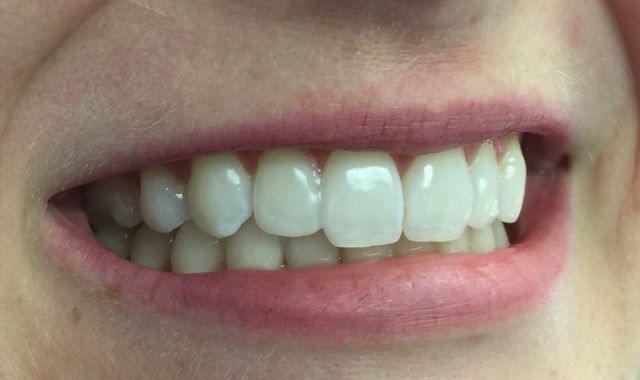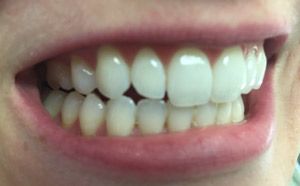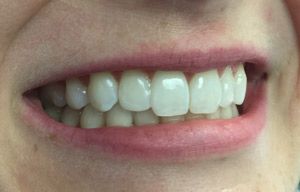The search for the best veneer system
The dental profession has witnessed great advances in cosmetic dental technology in the last century.

What was once thought to be impossible is now done every day with long-lasting, predictable results.
A quick review of some of these breakthroughs include Dr. Charles PIncus’ work in the late 1920s. Dr. PIncus developed the concept of the original dental veneer used in movies albeit with limited adhesion. In 1959, Dr. Michael Buonocore pioneered etching the enamel of teeth to increase retention. In 1978, Dr. Irwin Smigel introduced the concept of tooth bonding to the general public, and an exhibit at the National Museum of Dentistry features his pioneering contributions. In 1983, Dr. Harold Horn presented his work allowing porcelain shells to be bonded with composite resin to the facial surface of the tooth. Dr. John Calamia also pioneered a technique for bonding porcelain to the labial surface of teeth during that same time period. As porcelain veneers were refined and developed in the ensuing years, more dentists embraced the ability to add cosmetic restorative dentistry to the treatment suggestions offered to patients.
Today, there are several methods a dentist can choose from to improve the dental appearance of a patient who is not satisfied with the size, shape, length or color of his or her teeth.
Four of the more popular methodologies dentists utilize are porcelain veneers, preformed composite veneers, a matrix system to create the veneer and, of course, direct bonding.
All of the above systems can be effective in restoring a patient’s smile; however, each has its own unique set of challenges for the general dentist who is looking to provide an affordable, noninvasive option for those patients who do not want to invest a minor fortune to improve their dental appearance and/or do not want to have their healthy enamel irreversibly destroyed to cosmetically enhance their smile.
Some of the challenges of the above-referenced systems include the following:
Porcelain veneers, considered by some as the gold standard for cosmetic dentistry, require a sizable investment on behalf of the patient because it is very difficult to restore only one or two teeth with them. Thus, dentists often recommend placing six to 10 porcelain veneers to create symmetry. The cost of this service often results in patients saying, “Let me think about it.” More often than not, dentists realize that has come to mean, “thanks but no thanks.”
Porcelain veneers also often require tooth reduction, which is irreversible. Additionally, they need a diagnosis appointment, preparation and temporization appointment and one or several try-in appointments to achieve the right size, shape or color. Porcelain veneers also incur a laboratory fee and are not easily repairable (composite resin can be used, but a color disparity is readily apparent after a period of time).
Preformed resin veneers are an alternative that some dentists find intriguing. However, many find fitting preformed veneers challenging. Preformed veneers might be thought of as a one-size-fits-all shell that is available in small, medium and large sizes and requires trimming to adapt and fit to the tooth. The concern is how a preformed veneer that is fitted to the tooth, adapting it to the margins while customizing the size, shape and overall appearance, solves the patient’s unique set of problems. The following analogy represents the concern some dentists have shared with me: Did you ever do a wax up in dental school and then tried the casting on your patient’s tooth, which, unfortunately, did not seat properly? You attempted to work the margins to get the crown to fit. Sometimes that worked. Often it did not.
The preformed veneer technique can be complex and requires a significant investment of time, effort and energy to reverse-fit the preformed veneer to the patient's teeth while attempting to correct the patient’s esthetic issues. Simultaneously, the preformed veneer has to be customized to solve the patient’s esthetic problem and blend in with the size, shape and appearance of the adjacent teeth. That can be a challenge.
Matrix systems also are an interesting option. One system available today reminds me of a product used in the 1980s made by a different manufacturer where dentists attempted to create veneers using labial crown forms. The concept was exciting. Apply the composite into the preformed shell and light cure, then peel the preformed labial veneer crown form away. The goal was to have a finished veneer that required little finishing and polishing.
After removing the labial crown form, challenges sometimes included air bubbles appearing during finishing and polishing. Fixing that without having an oxygen-inhibited layer to bond to requires removal of the highly polished surface of the veneer. Then re-etching, adding to the defect and rebonding the entire facial surface worked best. However, it required a significant amount of time. If a spot repair was attempted where the void existed, it was very difficult to have it blend in seamlessly with the remainder of the veneer. It is possible to do-just not easy to accomplish.
Additionally, because the anatomy of the labial crown form is predetermined, it does not easily allow the dentist to create the illusion of reality using light reflections and color, which is achievable when a dentist applies composite resin directly to the teeth. Another issue occurred if the labial crown form moved slightly when curing. That created an esthetic challenge where the veneer could create the wrong illusion. While being a rare event, when it did occur, we had to completely remove the veneer and start all over.
Related reading: 5 ways to boost the whitening portion of your practice
Finally, dentists can directly bond composite resins to the enamel surface of the teeth, but the time, technique sensitivity and difficulty in achieving beautiful esthetics have been well-known limiting factors to many dentists. As one dentist wrote to me, “I am actually losing money doing tooth bonding.”
As a result, many dentists are looking for an easier, faster, more esthetically pleasing, lab-free, affordable solution to the above options that can be done in one visit.
Because dentists are aware of the recent advances in bonding systems used for placing composite restorations, more are revisiting how they might be the solution to their patient’s cosmetic dental problems. Dentists look for a product they can rely on to create natural-looking veneers in a short period of time without utilizing an outside laboratory where they can predetermine if their skill set can meet the patient's expectations before taking on a case without computer imaging.
Needless to say, there are challenges with placing composite resins to accomplish this goal.
Some of the problems dentists have in creating in-office composite resin veneers include the following:
- Composites often stick to the dentist's glove or plastic placement instrument, making it difficult to manipulate.
- Dentists often need to build up the veneer with a dentin, enamel and incisal layer, which adds considerable bulk. Add a tint or opaquer, and it becomes even bulkier.
- The dentist needs to have the artistic talent to shape the veneer. After placement, he or she often spends a lot of time carving the veneer back with burs to create the proper shape and contour. Then the dentist has a lot of finishing and polishing to do. Many dentists do not have the time or desire to do that.
- A composite veneer made chairside can take from 30 to 45 minutes per tooth, including finishing and polishing. Four veneers could require from two to three hours, which can disrupt your daily routine.
- Some patients are not satisfied with the final outcome. The veneer may look too large, too small, too opaque, too translucent or just not have the desired appearance. You can do chairside correction, but that is not always as easy as it sounds. It adds more time to the entire procedure that may not be available in your schedule.
- Dentists know that conventional composite resins are prone to staining and have durability issues.
- After completing the veneer, will the final result match what the patient had hoped for? Is there a way to achieve that result before taking on a case?
The ProVeneer System by Silmet addresses and solves the issues of conventional composites, as well as the concerns associated with porcelain and preformed veneers or matrix systems. ProVeneer is a system where a dentist can custom-make a beautiful veneer from scratch without requiring the artistic skill of a trained dental laboratory technician.
Additionally, ProVeneer makes cosmetic dentistry affordable to patients. Not only is there no laboratory bill, but it provides the dentist with a cost-effective system that achieves the final result in one visit where the patient and the dentist can determine prior to commencing work if the best cosmetic dentistry can be the least amount needed to correct the patient’s problem.
As a result, hearing patients say, "Let me think about it" is often replaced by your patient saying, "Can you cement that today?" That is a refreshing change.
ProVeneer also provides the dentist with a step-by-step guide for custom-making a Smile Preview Veneer. This guide is essential to determine if the patient is a candidate for the ProVeneer service.
Additionally, the following details some of the reasons why ProVeneer is different than other conventional cosmetic dentistry restorative products.
First, ProVeneer's unique polishabilty allows for a nonporcelain preview veneer to be created as thin as 0.1 mm compared to the conventional composites that are much thicker.
Adding a percentage of nonsilanated nanofill particles and high density spheres without altering the resin-to-filler ratio allows the resin matrix to flow around them and react without constraint.
Nanoclusters of silane-treated zirconia/silica are homogeny distributed to provide cross-link to surrounding resin and allow for high volume-wise filler concentration.
ProVeneer eliminates time-consuming layering, and the entire procedure, including any in-office laboratory processing and cementation, takes only 15 minutes per tooth.
When placing conventional composites, dentists are often aggravated by the tendency of the material to stick to the glove or the plastic placement instruments. That is eliminated with ProVeneer unique Bis-GMA- TEGDMA- UDMA-resin-balanced matrices.
ProVeneer also masks many tooth discolorations without requiring the use of an opaque agent.
Simultaneously, ProVeneer's chameleon ability maintains translucency to create a natural appearance.
In my hands, I have found the ProVeneer Resin Based Foundation Material (RBFM) is non-sticky. It goes and stays where you place it. The unique placement and handling properties associated with ProVeneer allow you to create a seamless emergence profile prior to curing the Smile Preview Veneer.
After creating several Smile Preview Veneers, light curing and removing the veneers from the tooth, one dentist said, “This is like the ideal preformed veneer. It perfectly fits my patient, it achieves the desired cosmetic appearance and it allows my patient to see if I can correct her problem in just a couple of minutes. Now all I have to do is cement it.”
Instead of having the challenges associated with standardized preformed veneers, the ProVeneer is custom-made and fitted to the exact size, shape and margins of the tooth in just two minutes. And, unlike conventional preformed veneers, the dentist has control of the illusions necessary to create a veneer that appears natural in relation to the adjacent teeth.
After the Smile Preview Veneer is removed from the tooth, the ProVeneer can be cemented to the tooth or cured in your lab if your patient exhibits bruxism or has other oral habits that would benefit from the laboratory phase.
Additionally, another benefit of ProVeneer is that your patient watches how unappealing teeth transform to a natural-looking smile without tooth preparation or any discomfort. As one dentist recently said to me, “After seeing the Smile Preview Veneer on her tooth, my patient said, 'Why didn’t you tell me about this before?'”
To help dentists learn how to create gorgeous veneers using the ProVeneer System, Silmet, in conjunction with the Silverman Institute of Cosmetic Dentistry, is making complimentary ProVeneer training available online for dentists who purchase a ProVeneer System.
Watch a video below of a patient's reaction to her ProVeneer smile:
Before

Please contact me if you have any questions or if you would like to send me a before photo of a case you are considering for your initial ProVeneer treatment. Send me six photos in jpeg format (medium close-up, full face, centric, protrusive and lateral excursion), and I will do my best to get back to you with comments or suggestions at my earliest opportunity. Please send your photographs to HS@EasySmileDentistry.com
In the next article, I will share tips on how to expand your cosmetic dentistry practice.
After a Smile Preview Veneer is placed on Tooth No. 7

About the author

Dr. Silverman is a graduate of the Washington University School of Dental Medicine. He is a fellow, American Society for Dental Aesthetics, and a diplomate of the American Board of Aesthetic Dentistry. His consulting services are exclusively in the area of smile enhancement and team building. During the past three decades, Dr. Silverman refined/developed one of the original porcelain veneer systems, was a consultant/clinician for dental manufacturers, developed and taught advanced tooth bonding systems to his colleagues, pioneered one of the original extreme dental makeovers, established the first dental spa in North America and patented one of the original OTC tooth whiteners. Dr. Silverman continues to develop new, simplified cosmetic dental systems and offers dentists unique hands-on training webinars, over-the-shoulder training programs, and a one-day on-site cosmetic dentistry team building programs designed to build bread-and-butter elective cosmetic dentistry practices. He has also served as a consulting and contributing editor to dental publications and writes extensively on how dentists can build the cosmetic component of their general dental practice.
Disclaimer: Dr Harvey Silverman receives products from Silmet and acts as a consultant to the company. In writing this article, Dr. Silverman did not receive compensation. Silmet also sponsors some of his programs in addition to sponsorship from the EasySmile, Inc.
ACTIVA BioACTIVE Bulk Flow Marks Pulpdent’s First Major Product Release in 4 Years
December 12th 2024Next-generation bulk-fill dental restorative raises the standard of care for bulk-fill procedures by providing natural remineralization support, while also overcoming current bulk-fill limitations.